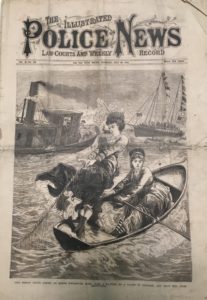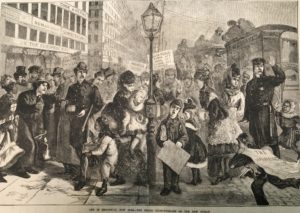The first in a two-part series, this blog post features an AAS-based undergraduate project, “Queering the Archive” at College of the Holy Cross. Under the advisement of Professor Stephanie Yuhl of the History Department, Carly Priest ‘18 and Emily Breakell ‘17 spent the summer searching for resources relevant to the history of transgender and gender-nonconforming people in the United States.
Based in Boston and printed in the late 19th-century, The Illustrated Police News was a sensationalist periodical widely-circulated on the east coast. Much like contemporary tabloids, serials like The Illustrated Police News were interested in stories that would sell. 
Their articles featured crime, subversive behavior, and any aberrations from mainstream culture that fell in-between— with little regard for the humanity of the people on whom they “reported,” or whether the stories presented were even true.

Though the content of publications like The Illustrated Police News were intentionally sensationalist (and therefore should not be viewed as reporting with journalistic integrity), The Illustrated Police News and similar serials ultimately offer important sources for our project, “Queering the Archive.” The articles, however aggrandized, discuss people on the fringes of society and frequently feature individual departures from nineteenth-century gender norms—even if only to reinforce mainstream social norms.
In July of 1876, The Illustrated Police News reported on Esther Shaw, a chambermaid who lived as a woman for most of her life (while The Illustrated Police News referred to Shaw with he/him/his pronouns, I will use she/her/hers to reflect what Shaw appears to prefer). The article, entitled “A Thirty-Years’ Masquerade: A Mulatto Chambermaid at New Orleans Proves to be a Male” sensationalized Shaw’s life and career as a maid.
Shaw became ill and was admitted to the women’s unit of a local hospital. Several days after her admittance, a medical student suspected Shaw was a biological male, and brought her into “the inspecting room.” Disturbingly, despite Shaw having “fought and plead[ed],” the report nonchalantly indicated the hospital’s medical staff forcibly physically examined Shaw to determine “the question of [her] sex.”
“A Thirty-Years’ Masquerade: A Mulatto Chambermaid at New Orleans Proves to be a Male” mirrors several other articles we found in the archives of the AAS. While Esther Shaw lived happily, normally, and quietly, as a woman, The Illustrated Police News treated her gender identity as a spectacle. Though sensationalist papers regularly dehumanized the people they reported on, accounts of those who lived outside the boundaries of their assigned gender—those who cross-dressed once to commit a crime, or who lived as a man or woman for thirty years, as Shaw did—were especially derisive. Headline descriptions of people who cross-dressed regularly included the terms “man-woman,” “freak,” and “unnatural.” Such accounts illustrated social anxieties surrounding deviance from gender normativity and positioned periodicals as cultural signposts to reinforce acceptable expression of gender.
On one hand, the story of Shaw stood as a typical example in the pattern we encountered in periodicals like The Illustrated Police News. As Illustrated by Shaw’s experience, invasive practices to identify gender and sex were common events in stories of people who cross-dressed. Like Shaw, these articles indicated enforcement of the gender binary by police and medical professionals in the nineteenth century.
On the other hand, the story of Shaw stands out from others we encountered in two ways: first, The Illustrated Police News account quoted Shaw in the article, allowing Shaw to explain, at least partly, why she cross-dressed. This marks a significant departure from other sensationalist stories we encountered, both in The Illustrated Police News and other serial publications, which frequently silenced those who subverted social norms. As The Illustrated Police News reported: “Shaw said…during [her] young days, [s]he wore smock frocks, and never felt at ease unless so attired. As [s]he grew up, [s]he found that man’s labor did not agree with [her], and therefore concluded that as a woman [s]he could succeed better.” Whether intentional or not, this brief description of Shaw’s life and preferences not only contextualize her life as a woman, but also gesture toward a depiction of Shaw as a whole person, a person who tried to live inside of gender norms, but found that they, like the boy’s clothes she tried to wear, never “felt” right. This moment of sympathy for Shaw renders her a potentially sympathetic character to The Illustrated Police News reader.
Second, the reporter further garners such sympathy by explaining why Shaw would have wanted to dress in feminine apparel in the context of other cross-dressing individuals. As The Illustrated Police News pointed out, “Numerous instances are on record of women assuming male attire to better further their ends…on the other hand it is a rare occurrence for a man to don feminine gear, and for years carry out the deception.” In the patriarchal society of the nineteenth-century, biological females sometimes chose to live as men in the search for better jobs, better pay, and better treatment. Biological males who lived as women, therefore, existed in a more enigmatic space and were therefore pushed further to the margins. A society dominated by cisgender people—i.e., people that identify with the gender assigned to them at birth—would have a harder time understanding why a biological male would want to live as a woman. Given the prevailing attitude that no person would choose to live as a woman, male-to-female transitions were riskier, and more criminalized than female-to-male.[1]

Prevalent commentary on race throughout this article invites further speculation about the societal norms the unnamed The Illustrated Police News journalist assumed. Take the initial description of Esther: “Shaw is a medium-sized, delicate looking mulatto, about 30 years of age, with a few scattered hairs on his lip and chin, not any more than a large proportion of creole negroes or sufficient to betray his sex.” As was common practice in the 19th-century, the author of the article identified Esther as “Mulatto” in the subtitle before they flagged Shaw’s non-conforming gender identity. This served to portray Esther as a particular social conundrum: not only of mixed sex, but also of mixed race. In short then, the story of Esther Shaw was not that of “A Thirty-Years’ Masquerade.” Rather, her story is one of a person who lived and worked as a woman of color in a time when mixed race and gender rendered Esther Shaw doubly marginalized.
[1] The News Desk. “Arresting dress: A timeline of anti-cross-dressing laws in the United States.” PBS Newshour. 31 May 2015. http://www.pbs.org/newshour/updates/arresting-dress-timeline-anti-cross-dressing-laws-u-s/.

One thought on ““the question of [her] sex”: Transgender Histories in Nineteenth-Century News”